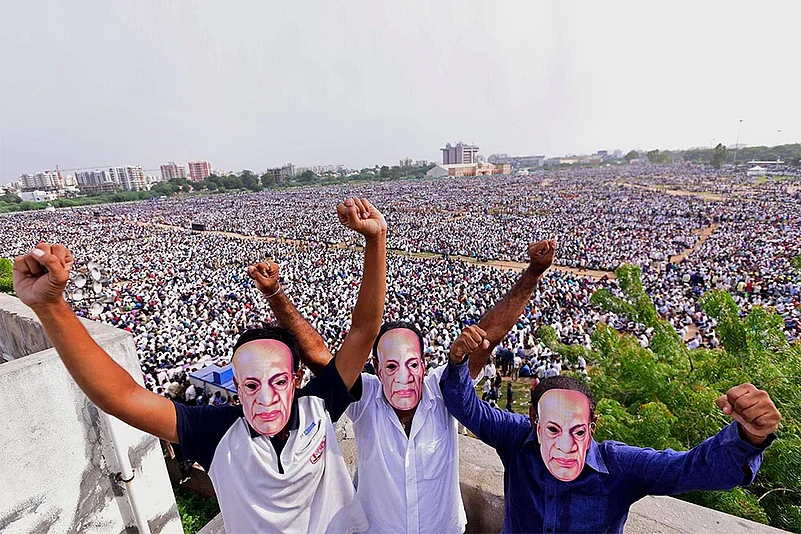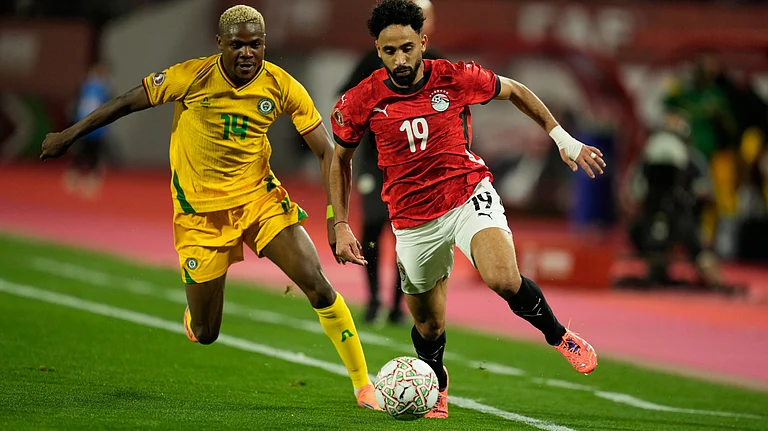Wheels Within Wheels
- Kadva and Leuva Patels are agitating, while Kachia and Anjana Patels are on the OBC list already
- Feeling excluded by the quota policy, Patels severed ties with the Congress in 1985 with a riot
- Patels demand a quota within the 27 per cent OBC quota, not a slice of the general category pie
***
Last year in August, when Hardik Patel first marshalled Patidars to fight for reservation under the Other Backward Classes (OBC) quota, the agitation was vilified as a ruse to frustrate the government into reviewing and finishing off reservation. A year later, the Patidars have not turned tail; in fact, they have started joining hands with other intermediate castes eyeing reservation. Pundits, therefore, are scrying to understand why Patidars, who decades ago fought to end reservations, are jostling for a share of the quota pie.
It’s partly rooted in identity, partly economics. Some cite jealousy towards castes in the OBC list that now hold bureaucratic clout, the frustration of being pushed to the fag end of the shrinking queue for jobs, or a desire for a new kind of mobility to reclaim their dominant position in society that has been “upset by reservation”. Some still argue it is designed to end reservation quota to the backward classes.
The name Patidars (literally titleholders) refers to landowners who were originally of the Kanbi caste, claimed to be descendants of the north Indian Kurmis. Sociologists say they were part of the Shudra varna. The British system of collecting fixed revenue from communities empowered the Patidars, giving them control over finance and also turning some of them into moneylenders. This power let them assume the title of Patel, meaning village headman.
The four sub-groups of Patidars are the Kadva and Leuva Patels—both are agitating for reservation—and the Kachia Patels (vegetable sellers) and Anjana Patels (who claim descent from Kshatriyas and Jats), both of whom are part of the OBC list.
An inflection point came when land reforms were initiated in the 1950s by Sardar Vallabhbhai Patel (a Leuva Patel) from Saurashtra (home to the Kadvas) and central Gujarat (home to the Leuvas). This formalised the land ownership of Patidars in Gujarat. At that time, they accounted for 27 per cent of the state’s population.
Next, a bigger push to trade. “In the 1960s and ’70s, many Patidars moved to the diamond-cutting industry and have monopolised it ever since,” says Arjun Patel, a sociologist and professor at the Centre for Social Studies in Surat. The diamond trade is centred in Surat and the Patels have dominated other commercial activities that originated subsequently in the city, such as textile, housing and now zari work.
With money came the desire for upward social mobility, for which they rode piggyback on politics by supporting the Congress. They severed those ties with a bloody riot in 1985, when they felt that the then Gujarat CM Madhavsinh Solanki’s reservation policies excluded them from higher education. Patidars, however, continued to flourish in agriculture and commerce.
“Initially, many of the OBC communities in Gujarat didn’t want the backward tag that came with inclusion in the OBC list, considering it derogatory,” says Arjun Patel. “Despite being in the Shudra category, the Patidars, being in an influential position, wanted to be identified among the elite castes when reservation was first proposed.” However, the castes that got reservation status inched up the social ladder and began populating the bureaucracy.
Cut to the 1990s, Patidar support finally put the BJP in power in the state. The well-to-do Patidars supported members of their own communities and accommodated them in all businesses and in education. At present, there is 15 per cent management quota in private education institutes in Gujarat, mostly owned by Patidars. The community’s support is said to have kept the BJP in power for nearly 25 years. Around a third of the party’s MLAs and most of the influential cabinet ministers are Patidars.
By the 2000s, the percentage of Patidars in Gujarat’s population had begun to dip, and reached 11-13 per cent. The slump hit many industries Patidars were engaged in and successive droughts, coupled with low support prices, brought the agriculturists too to their knees. This angst and the feeling of being discriminated against that had been brewing goaded more Patidars into revisiting the reservation question.
“The intermediate castes are just above the OBCs, but now there is pressure from the OBCs due to education and bureaucratic clout through government jobs, which has enabled upward mobility among the OBC communities,” says Arjun Patel. “The OBCs are now more politically aware and contest against the elite castes during local body polls. Patidars also see this as a benefit of reservation, which upsets the historical monopoly of the elite castes. There is a demand for reservation by intermediate castes in various states, who were earlier opposed to reservation, but have revised their stand. They seek a dominant position in society and have witnessed the upward social mobility that came with reservation to those who
were given OBC status.”
Gaurang Jani, a sociologist with Gujarat University, told Outlook a large number of the Kachia and Anjana Patels had joined the police force through reservation, causing heartburn among non-OBC Patel aspirants who lost the race for a few marks.
The internecine rivalry became evident last year when Patidars agitating for reservation in Ahmedabad’s GMDC grounds attacked on-duty constables, many of whom were Kolis, Kachia and Anjana Patels.
“Had I been from the general category, the marks I scored in the entrance exam wouldn’t have got me a police job,” says police constable Nitesh Makwana. “But, since I am from the Koli community, which has OBC status, I was hired and posted to the city police. So, clearly, the quota did give me an opportunity and helped me become the first person in my family with a fixed income, much more than my father, who was a farm labourer.”
Kolis, placed lower in the varna system than Patidars, were once sharecroppers under them. Their OBC status gave them some amount of social mobility and many feel this has made the Patidars envious of them. This, ironically, reminds Patidars of the ill-will they faced from the Kshatriyas (called Durbar in Gujarat) when land reforms in Saurashtra empowered them.
“The benefit of reservation goes to a lot of castes under the OBC category that did not have capital for business or land for agriculture and were traditionally engaged in carpentry, weaving and other skill-based trade. There is some traditional resentment towards those who get college admission and government jobs through reservation,” says Divyesh Chavada, a member of the Koli caste who quit the BJP to form the Gujarat Jan Chetna Party. “This becomes prominent and swells into an agitation whenever there is a slump in industry or when drought affects agriculture. The youth are misled into believing that reservation is eating into their future.”
Alpesh Kathiriya, Surat convenor of the Hardik Patel-led Patidar Anamat Andolan Society (PAAS), insists the current generation of Patidars are interested in education. “All new businesses also demand education and not just capital,” he says.
Kathiriya, who has an LLB degree, says he scored 80 per cent in his Class 12 boards, but could not gain admission to a bachelor’s programme in either computer applications or business administration because “students from communities with reservation made it with less marks”. “So I studied B.Com,” he says.
But, many discard this view that the agitation is for education and government jobs alone as too simplistic to explain the Patidar youth’s angst.
“Patidars want to be a dominant caste,” says Bhavna Patel, a former government employee and former functionary of the Rashtriya Swayamsevika Sangh (women’s wing of the RSS). “The lack of education they cite is mostly because of a conscious choice to drop out of school and pursue business or agriculture.” A Marathi Brahmin married to a Gujarati Koli (OBC), she recommends inter-caste marriages to end caste differences.
“When Patidars go to register land, they realise that members of communities lower than them in the caste system are sitting across the desk,” says Bhavna Patel. “But the Patidars’ demand for reservation is a faux demand and is aimed at removing reservation because direct anti-reservation agitations have never helped. But they cannot be accommodated in the current OBC list because they are neither educationally backward nor socially backward.”
To enter the list, they need political backing. And, having in a sense failed to leverage the patronage of both the BJP and the Congress in this respect, it’s taking on an autonomous spirit.
Realising that losing Patidar support could weaken their electoral prospects, the BJP had tried to salvage the relationship. While Anandiben Patel was the chief minister, the government passed an ordinance introducing a fresh 10 per cent reservation under a newly declared Economically Backward Class (EBC) category. Though the Gujarat High Court struck it down as unconstitutional, the Supreme Court restored it temporarily until it could decide on the issue.
But Patidars rejected the quota, calling it “lollipop politics”. They wanted reservation within the 27 per cent under the OBC category instead of being apportioned a pie from the general category share. Patidars didn’t bite the bait because they were sure this additional quota wouldn’t stand judicial scrutiny.
This gap between reality and aspiration is what gave the Aam Admi Party (AAP), born and brought up in Delhi, elbow room in Gujarat. Hardik recently issued statements supporting Delhi chief minister Arvind Kejriwal. It is this new-found love that let AAP hold its rally recently in Yogi Chowk, which is at the centre of the Patidar community-populated Varachcha in Surat. During the rally, Kejriwal’s speech centred around Patidars and their agitation, though the crowd also had circumspect Thakores and Kolis. At the entrance to the meeting ground, Hardik leered down at the spectators from a poster put up since his release from prison a few months back, where he was held on sedition charges. Its legend reads: “Babbar (lion) is back”.
By Ushinor Majumdar in Ahmedabad and Surat


























